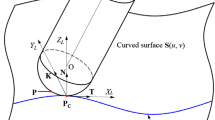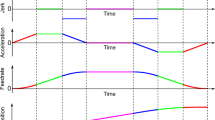Abstract
In 5-axis machining, the existing tool’s axis vector optimization methods are limited since they only consider the global collision between the tool and the workpiece while aiming at the ball-nosed cutter. A multi-factor vector optimization method for the face milling cutter shaft is proposed to solve this problem. This method comprehensively considers machining global collision, cutting force, the angular displacement of a rotating shaft, and angular speed. An improved global collision detection method of cutter axis vector based on the NURBS surface principle is developed, and a global collision detection algorithm is employed to determine the cutter machining global collision. The relationship model between the end-milling cutter axis vector and cutting force variation is established to optimize the cutting force. In addition, an optimization model of angular displacement and velocity of the machine tool’s rotating axis is proposed based on Dijkstra optimal path algorithm. The CAM software simulation and experimental validation are conducted using a large propeller with a complex surface. The tool’s axis vector optimization algorithm is applied to the propeller results. Comparing the tool’s axis vector optimization results to those obtained without optimization, it is discovered that the surface workpiece’s machining quality has significantly increased.





















Similar content being viewed by others
Data availability
The datasets used or analyzed during the current study are available from the corresponding author on reasonable request.
Code availability
Not applicable.
References
Wu BH, Luo M, Zhang Y et al (2008) Advances in tool path planning techniques for 5-axis machining of sculptured surfaces[J]. J Mech Eng 44(10):9–18
Youn JW, Jun Y, Park S (2003) Interference-free tool path generation in five-axis machining of a marine propeller[J]. Int J Prod Res 41(18):4383–4402
Liang YS, Zhang DH, Ren JX, Chen ZZ, Xu YY (2016) Accessible regions of tool orientations in multi-axis milling of blisks with a ball-end mill[J]. Int J Adv Manuf Technol 85(5–8):1887–1900
Wang J, Luo M, Zhang DH (2018) A GPU-accelerated approach for collision detection and tool posture modification in multi-axis machining[J]. IEEE Access 6:35132–35142
Bi QZ, Wang YH, Ding H (2010) A GPU-based algorithm for generating collision-free and orientation-smooth five-axis finishing tool paths of a ball-end cutter[J]. Int J Prod Res 48(3–4):1105–1124
Wang XC, Ghosh SK, Li YB, Wu XT (1993) Curvature catering - a new approach in manufacture of sculptured surfaces (part 1. theorem)[J]. J Mater Process Technol 38(1–2):159–175
Kim YJ, Elber G, Barton M, Pottmann H (2015) Precise gouging-free tool orientations for 5-axis CNC machining[J]. Comput Aided Des 58:220–229
Lavernhe S, Tournier C, Lartigue C (2008) Optimization of 5-axis high-speed machining using a surface based approach[J]. Comput Aided Des 40(10–11):1015–1023
Bizzarri M, Barton M, Rist F, Sliusarenko O, Pottman H (2021) Geometry and tool motion planning for curvature adapted CNC machining[J]. ACM Trans Graph (TOG) 40(4):1–16
Fu GQ, Gu TD, Gao HL (2018) Geometric error compensation for five-axis ball-end milling by considering machined surface textures[J]. Int J Adv Manuf Technol 99:1235–1248
Morishige K, Takeuchi Y (1997) 5-axis control rough cutting of an impeller with efficiency and accuracy[C]. IEEE Int Conf Robot Autom 1241–1246
Juna CS, Chab KD, Lee YS (2003) Optimizing tool orientations for 5-axis machining by configuration-space search method [J]. Comput Aided Des 35(6):549–566
Ho MC, Hwang YR, Hu CH (2003) Five-axis tool orientation smoothing using quaternion interpolation algorithm[J]. Int J Mach Tools Manuf 43(12):1259–1267
Wang N, Tang K (2007) Automatic generation of gouge-free and angular-velocity-compliant five-axis tool path [J]. Comput Aided Des 39(10):841–852
Li S, Tang M, Luo M (2011) Optimal tool orientation planning for five-axis machining of OpenBlisk[M]. 2011 Fourth Int Conf Intell Comput Technol Autom 1138–1141
Hu PC, Tang K (2011) Improving the dynamics of five-axis machining through optimization of workpiece setup and tool orientations[J]. Comput Aided Des 43(12):1693–1706
Gan Z, Chen Z, Zhou M (2016) Optimal cutter orientation for five-axis machining based on mechanical equilibrium theory[J]. Int J Adv Manuf Technol 84(8):989–999
Erdim H, Lazoglu I, Ozturk B (2006) Feed rate scheduling strategies for free-form surfaces[J]. Int J Mach Tools Manuf 467:747–757
Lopez D, Lacalle N, Lamikiz A (2009) The high performance combination machine tools and high productivity machining center[M]. Springer, London
Duan X, Peng F, Yan R (2016) Estimation of cutter deflection based on study of cutting force and static flexibility[J]. J Manuf Sci Eng 138(20):041001–0410015
Sheng M (2016) Automatic programming research of five-axis machine using flat knife based on CATIA[D]. Shenyang Aerospace University, Shenyang
Funding
This research is greatly supported by the National Natural Science Foundation of China (No. 51975019).
Author information
Authors and Affiliations
Contributions
All authors contributed to the study conception and design. Material preparation, data collection, and analysis were performed by Pengrui Zhao and Zirui Cao. The first draft of the manuscript was written by Pengrui Zhao, Zhifeng Liu, and Zhixiong Li, and all authors commented on previous versions of the manuscript. Zhixiong Li is responsible for the performance of data. All authors read and approved the final manuscript.
Corresponding author
Ethics declarations
Ethics approval
Not applicable.
Consent to participate
Not applicable.
Consent for publication
Not applicable.
Competing interests
The authors declare no competing interests.
Additional information
Publisher's note
Springer Nature remains neutral with regard to jurisdictional claims in published maps and institutional affiliations.
Rights and permissions
Springer Nature or its licensor (e.g. a society or other partner) holds exclusive rights to this article under a publishing agreement with the author(s) or other rightsholder(s); author self-archiving of the accepted manuscript version of this article is solely governed by the terms of such publishing agreement and applicable law.
About this article
Cite this article
Zhao, P., Liu, Z., Li, Z. et al. Research on tool axis vector optimization when face milling complex surfaces. Int J Adv Manuf Technol 128, 5081–5099 (2023). https://doi.org/10.1007/s00170-023-12031-7
Received:
Accepted:
Published:
Issue Date:
DOI: https://doi.org/10.1007/s00170-023-12031-7




